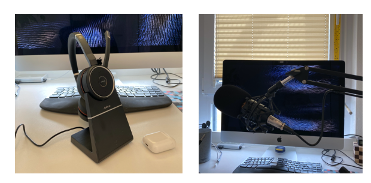Not only since virtual teams and home offices have become increasingly established in companies, video and telephone conferences are already being used as a substitute for personal meetings. Nevertheless, the stronger focus on the new methods in the context of New Work means that the right virtual meeting software and the right equipment are becoming significantly more important.
In this article, I would like to explain in more detail what exactly is important here and which factors play an essential role. All information reflects a Summary out Chapter 3.4 of my book Virtual teams and home office from Springer Verlag contrary.
Virtual meetings
At the beginning of the COVID-19 pandemic in March 2020 in particular, it became clear how important it is to replace personal meetings with virtual conferences. This measure was even used so heavily by companies that there were occasional failures due to system overload.
Most companies are currently using the market leader zoom in the area for virtual meeting software. In addition to a low-cost monthly flat rate of EUR 14 per user, it also offers a number of other advantages. So you can use zoom not only take part in video conferences by phone, but also look at virtual documents with colleagues. Of course, the software corresponds to a secure, encrypted video solution.
Alternatively, companies can also obtain their virtual meeting software from open source offerings such as Kopano and Jitsi. Or in the commercial sector via Skype, Goto Meeting or Webex.
Choice of the right microphone
But even the best virtual meeting software can only be used efficiently if the other equipment is also at an adequate level. First and foremost, this includes choosing the right microphone. In particular, because the hardware already installed in the PC is often insufficient (see also the figure below).

and a condenser microphone (T-Bone 400) with Steinberg HR12 audio interface
for video conferencing (Lindner, 2020)
In principle, I therefore recommend that you pay attention to the following when deciding on the right equipment:
Sound: The sound is particularly crucial for professional and comfortable meetings. The better they can be understood, the more pleasant the conference will be for the other participants.
Microphone & Sound: The sound is particularly crucial for professional and comfortable meetings. The better they can be understood, the more pleasant the conference will be for the other participants. Above all, the microphone should therefore transmit a clear voice. That’s why I work, for example, with a studio microphone with an audio interface (from 200 EUR in a set).
Webcam: I recommend a budget in the range of 150 EUR for a high-quality product.
Headset: In my opinion, a Bluetooth version (100-300 EUR) with active noise suppression should be used for the headset. This also has the advantage that the ambient noise for the caller is reduced.
Conclusion for virtual meeting software and the right equipment
The COVID-19 pandemic in particular has clearly shown how important good virtual meeting software and the appropriate equipment are. Even if it is not always necessary to set a high budget, I still recommend buying at least a high-quality microphone or headset.
In the area of software, you can also choose between commercial and free open source software (Chapters 3.1 and 3.3 of my book). You should make this dependent primarily on the corporate strategy. But it is also important that you let the virtual meeting software interact in a meaningful way. This means that you either get all the necessary components from the same provider or, in the open source area, put together a package with the corresponding elements yourself. Only in this way can you ultimately establish an efficient software landscape in your system that your employees will also feel comfortable using.
Tip: Read my new book: Virtual Teams & Home Office at Springer Gabler or book me for a talk.
[fotolia]


